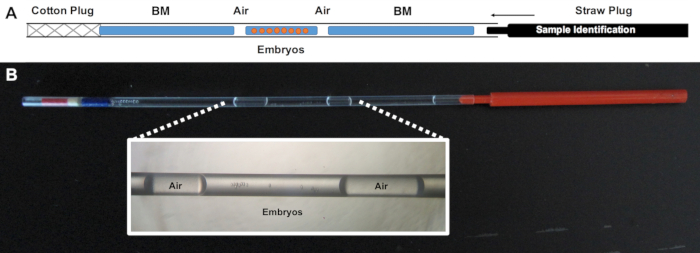Rabbit Embryo Vitrification Using Cryogenic Straw: An Ultra-Rapid Cooling Technique to Preserve Rabbit Embryos for Long-term Storage
Abstract
Source: Garcia-Dominguez, X. et al. Minimally Invasive Embryo Transfer and Embryo Vitrification at the Optimal Embryo Stage in Rabbit Model. J. Vis. Exp. (2019)
In this video, we describe the procedure for vitrification of harvested rabbit embryos at desired development stage using ethylene glycol and dimethyl sulfoxide as cryoprotectants and cryogenic straw as the carrier system. The vitrified embryos have high survival rate and can be stored for an extended period until use.
Protocol
All procedures involving animal models have been reviewed by the local institutional animal care committee and the JoVE veterinary review board.
1. Embryo Vitrification
- Perform all the manipulations at room temperature (around 22 °C) to reduce the vitrification solution toxicity at warmer temperatures.
NOTE: Embryos can be moved using 0.1–2 µL automatic pipette in this protocol, but other similar devices to move the embryos dragging the minimum volume can be suitable. - Vitrify the embryos in a two-step addition procedure:
- Place the embryos for 2 minutes in equilibrating solution consisting of 10% (v/v) ethylene glycol and 10% (v/v) dimethyl sulfoxide dissolved in base medium (BM). (Composition of BM: Dulbecco's Phosphate-Buffered Saline (DPBS) supplemented with 0.2% (w/v) of Bovine Serum Albumin)
- Move the embryos (from step 1.2.1) for 1 minute into vitrification solution consisting of 20% (v/v) ethylene glycol and 20% (v/v) dimethyl sulfoxide dissolved in BM.
- Load the embryos into a 0.25 mL plastic ministraw (which contains one closed end with a cotton plug and one open extreme). The process is schematized in Figure 1.
- Couple the closed end of 0.25 mL ministraw with the appropriate microdispenser (e.g. Captroll III®).
- Aspirate BM until 1/3 of the straw length, following by a small air bubble.
- Aspirate the embryos in a volume of 40 µL of vitrification solution, followed by another small air bubble.
- Aspirate BM until the first liquid fraction (step 1.3.2) reaches the cotton.
- Close the open end with a straw plug.
- Perform step 1.2.2 while step 1.3 is being done to ensure that no more than one-minute elapses, which would be toxic to embryos.
- Plunge the ministraw directly into liquid nitrogen to achieve vitrification.
- Store the ministraw in a dewar for nitrogen for the desired time.
Representative Results

Figure 1: Schematization of correctly loaded straw. A) BM refers to the embryo manipulating media employed during vitrification. Embryos must be loaded in vitrification solution. B) Macroscopic appearance of the loaded straw with a magnified detail of the embryo position. This large-volume device allows us to vitrify large number of embryos, unlike minimum volume devices. Furthermore, the handling of this device is easier compared with minimum volume devices.
Divulgazioni
The authors have nothing to disclose.
Materials
| Bovine Serum Albumin (BSA) | VWR | 332 | |
| Dimethyl Sulfoxide | Sigma Aldrich | W387509 | |
| Dulbecco's phosphate-buffered saline (DPBS) | Sigma Aldrich | D5773 | Without calcium chloride. |
| Ethylene Glycol | Sigma Aldrich | 102466-M | |
| Liquid Nitrogen | Air Liquide | P1505XXX | |
| Plastic Straw 0.25 mL | IMV – technologies | 6431 | |
| Stereomicroscope | Leica | MZ16F | There are cheaper options such as Leica MZ8 or Nikon SMZ-10 or SMZ-2B, to name a few. |
| Straw Plug | IMV – technologies | 6431 |

